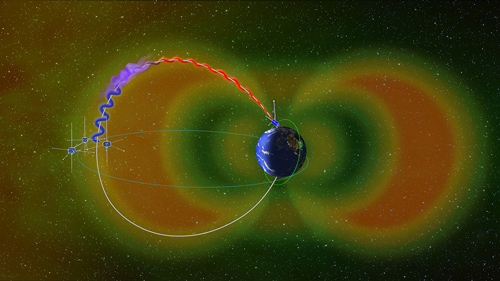
Scientists Discover the Most Powerful Solar Storm in Human History — Occurred 14,300 Years Ago
In a revolutionary finding that alters our comprehension of extreme space weather, an international group of researchers has pinpointed the most intense solar particle event ever documented — one that took place around 12,350 BC during the Late Glacial period, over 14,300 years in the past. A study featured in Earth and Planetary Science Letters reveals that this solar explosion overshadows all previously identified events and carries significant implications for space science as well as archaeology, climate studies, and contemporary infrastructure planning.
Employing intricate chemistry-climate modeling alongside ancient radiocarbon data, the research team revealed that this tremendous solar energy surge — classified as an Extreme Solar Particle Event (ESPE) — was approximately 18% more potent than the AD 775 occurrence, the previous record holder, and about 500 times more vigorous than the strongest storm detected during the age of modern satellite technology.
Radiocarbon as an Indicator of Solar Activity
This revelation arises from the investigation of an exceptionally pronounced increase in radiocarbon (^14C) levels found within tree rings dating back to approximately 12,350 BC. These tree rings serve as natural chronological records of atmospheric conditions, including traces of elevated radiation from solar storms.
“Radiocarbon is generated when high-energy solar particles interact with nitrogen atoms in Earth’s atmosphere,” stated Kseniia Golubenko, postdoctoral researcher at the University of Oulu in Finland and the study’s lead author. “This process leaves an imprint that trees absorb and maintain, creating a detailed chemical record of solar activity.”
Earlier radiocarbon research indicated inconsistencies, but without adequate modeling tools, scientists were unable to assess the event’s magnitude — until now.
Connecting Ice Age and Solar Physics with Innovative Climate Models
To decipher the extent and timing of this ancient solar storm, researchers constructed an advanced atmospheric chemistry-climate model: SOCOL:14C-Ex. Unlike previous iterations, which were confined to stable conditions during the post-Ice Age (the Holocene period), this novel model includes Late Glacial climate conditions — a period characterized by temperature fluctuations, expanded ice sheets, and varying ocean-carbon circulation.
By simulating how radiocarbon would move through the atmosphere of that glacial era, the model accurately dated the solar incident and gauged its intensity. Notably, the solar storm likely impacted Earth in early March of that year, based on the distribution of radiocarbon throughout the tree ring layers.
“Our discoveries indicate that tracing solar events across periods vastly different from present-day climates is both feasible and scientifically sound,” remarked Golubenko.
Modern Consequences: What If It Happened Today?
The most concerning conclusion from the study is the potential devastation a similar-scale event could impose on our contemporary civilization.
Possible repercussions include:
– Disruption of satellite GPS, communication, and Earth observation systems
– Extensive power grid outages lasting from hours to weeks
– Serious radiation risks for astronauts and flights over polar routes
– Worldwide radio blackouts affecting aviation and emergency response
– Increased atmospheric drag resulting in reduced satellite lifespan
It’s a scenario frequently explored in science fiction — yet this study confirms it’s not merely theoretical.
“If an incident of this scale were to happen today, the economic and technological fallout could be immense,” warned Golubenko. “This establishes a new standard for risk evaluation in our increasingly interconnected, technology-reliant society.”
A Radiocarbon Marker for Archaeologists
The 12,350 BC solar occurrence not only influences astrophysics but also revolutionizes archaeology.
Vast solar storms produce global radiocarbon spikes referred to as Miyake events (after Japanese researcher Fusa Miyake). These sharp, identifiable ^14C increases act as “cosmic timestamps,” enabling scientists to assign exact calendar dates to wooden artifacts and archaeological layers — even extending beyond the usual boundaries of radiocarbon dating.
For example, earlier Miyake events have assisted in dating Viking settlements in North America and Neolithic ceremonial sites in Europe down to a single year. The newly validated 12,350 BC event now extends this capability back into the Late Glacial period, offering one of the earliest absolute dating markers in human prehistory.
“It allows us to place ancient civilizations and environmental occurrences along a fixed timeline much earlier than was previously feasible,” stated an archaeologist unrelated to the study.
Enhancing the Solar Storm Registry
This finding adds to a list of known ancient events:
– AD 775 and AD 994 — previously the largest documented solar particle events
– 663 BC
– 5259 BC
– 7176 BC
However, the 12,350 BC incident stands out as the most powerful and the oldest scientifically confirmed. Further candidate events are under examination, suggesting that such extreme flares, while uncommon, are recurring phenomena in solar activity.
What makes this new discovery even more captivating is that